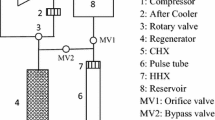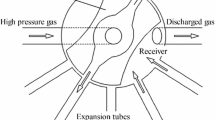Abstract
The multi-bypass structure established a radial gas channel between the regenerator and the pulse tube in the pulse tube refrigeration. Numerical results of the flow field were obtained in two dimensions by the finite element method. Afterward, the position and thermal state of selected gas parcels were tracked with the tracking algorithms. The multi-bypass structure generates vortices at the pulse tube, and the existence of these vortices inhibits the capacity of the gas parcels to take heat away from the cold end. Placing porous material near the multi-bypass structure, it could effectively reduce the vortices in the pulse tube.










Similar content being viewed by others
References
R. Radenbaugh, Refrigeration for superconductors. Proc. IEEE 92(10), 1719–1734 (2004)
https://www.shicryogenics.com/applications/research-development/
H. Zhang, W. Chen, Q. Rui, Design of cryogenic long-wave infrared detection system. J. Phys. Conf. Ser. 2295(1), 012008 (2022)
H. Zhao, H.S. Feng, R. Hu, Cryogenic system design and performance test of calibration magnet. IOP Conf. Ser. Mater. Sci. Eng. 1240(1), 012141 (2022)
R. Radebaugh, A review of pulse tube refrigeration. Advances in cryogenic engineering. Vol. 35B-Proceedings of the 1989 Cryogenic Engineering Conference. 1990, 35: 1191–1205.
X.M. Pang, W. Dai, X.T. Wang et al., Theoretical and experimental study of a gas-coupled two-stage pulse tube cooler with stepped warm displacer as the phase shifter. Cryogenics 92, 36–40 (2018)
J. Olson, T.C. Nast, B. Evtimov, et al., Development of a 10 K pulse tube cryocooler for space applications. Cryocoolers 12. Springer US, 2003: 241–246.
I. Garaway, M.A. Lewis, P.E. Bradley, et al., Measured and calculated performance of a high frequency, 4 K stage, He.3 regenerators. Georgia Institute of Technology, 2008.
G.W. Swift, Thermoacoustic engines. J. Acoust. Soc. Am. 84(4), 1145–1180 (1988)
Y. Zhou, J. Wang, W. Zhu, et al., (1994). Multi-bypass pulse tube refrigerator: U.S. Patent 5, 295, 355.
J.H. Cai, J.J. Wang, W.X. Zhu, Y. Zhou, Experimental analysis of the multi-bypass principle in pulse tube refrigerators. Cryogenics 34(9), 713–715 (1994)
X. Liu, L. Chen, W. XianLin, Attaining the liquid helium temperature with a compact pulse tube cryocooler for space applications. Sci. Chin. Technol. Sci. 63(3), 434–439 (2020)
D. Gedeon, (2014), SAGE10 User Guide..
J. Gary, (2008), Abbie ogallagher, REGEN3.3: User Manual
Y. Ling Chen, E.L. Zhang, T. Li, X. Wei, CFD analysis of thermodynamic cycles in a pulse tube refrigerator. Cryogenics 50(11), 743–749 (2010)
J.S. Cha, S.M. Ghiaasiaan, P.V. Desai, J.P. Harvey, C.S. Kirkconnell, Multi-dimensional flow effects in pulse tube refrigerators. Cryogenics 46(9), 658–665 (2006)
Z. Zihui, D. Sijie, J. Ruizhi, D. Kejun, H. Li’an, W. Bo, Vortex characteristics of a gas cyclone determined with different vortex identification methods. Pow Technol 404, 117370 (2022)
F.L. Ponta, Analyzing the vortex dynamics in bluff-body wakes by Helmholtz decomposition of the velocity field. Fluid Dyn Res 38(7), 431 (2006)
W.C. Ward, G.W. Swift, Design environment for low amplitude thermoacoustic engines (DeltaE). J. Acoust. Soc. Am. 95, 3671–3672 (1994)
Author information
Authors and Affiliations
Contributions
ZW: Conception, math, visualization, writing original manuscript. CF: conception. LL: writing, review, and editing. YZ: writing, review, and editing.
Corresponding authors
Ethics declarations
Competing interests
The authors declare no competing interests.
Additional information
Publisher's Note
Springer Nature remains neutral with regard to jurisdictional claims in published maps and institutional affiliations.
Rights and permissions
Springer Nature or its licensor (e.g. a society or other partner) holds exclusive rights to this article under a publishing agreement with the author(s) or other rightsholder(s); author self-archiving of the accepted manuscript version of this article is solely governed by the terms of such publishing agreement and applicable law.
About this article
Cite this article
Wang, Z., Fang, C., Zhou, Y. et al. Investigation of the Flow Field in the Pulse Tube Refrigerator with the Multi-Bypass Structure Through the Finite Element Method. J Low Temp Phys 213, 138–153 (2023). https://doi.org/10.1007/s10909-023-02992-0
Received:
Accepted:
Published:
Issue Date:
DOI: https://doi.org/10.1007/s10909-023-02992-0




